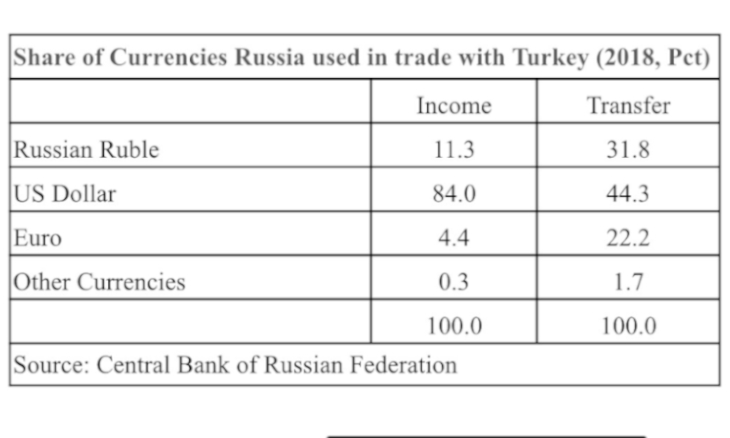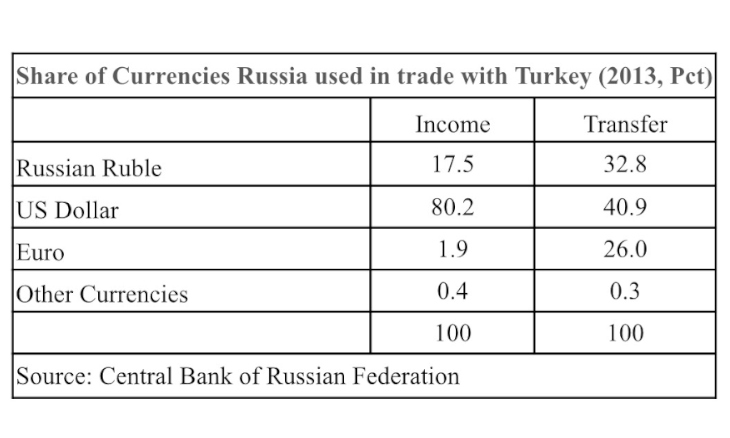Turkish lira nowhere to be found in Russian trade
Russia's strategy is quite clever; it continues to accumulate reserves by using dollar and euro for its exports while using ruble for one third of imports. By receiving 7-8 percent of its net foreign trade in ruble, it creates demand for its currency at the same time.More so, Russia is trying to recruit Turkey as a customer for its Russian made SWIFT alternative SPFS and again homemade credit card system MIR.
Trading with domestic currencies and reducing dollar dominance is an issue that Turkey and Russia have long been declaring intentions about in diplomatic space.
President Erdoğan, back in late 2016, had suggested to Russia and Iran to "trade using national money" and proposed that "the importer pays in the currency of the exporter". According to this proposal; Turkey would pay for Russian imports in rubles.
I had written back then that this proposal would be difficult to put into practice. Because only declaration of intensions existed, nothing else.
Similar news came up in early October; it was said that Russian Finance Ministry had signed a bilateral agreement with Turkey and with that "the usage of ruble and lira in mutual trade would gradually increase."
Also, it was emphasized that a financial market infrastructure in accordance with the agreement would be created, and currencies of both countries would become more attractive for commercial institutions. Two points were underlined once again; Turkish banks connecting to the SWIFT alternative SPFS system, which Russia put in place last year after the Ukraine crisis, and extending the usage of Russian MIR cards in Turkey.
These two are not functional systems. We know nothing about SPFS. MIR, on the other hand, was on the agenda in 2017 but has not progressed at all since.
Let's get to the point which resides in the data Russian Central Bank published on Oct. 29. A breakdown of foreign currencies Russia used in its trade with Turkey was published. According to the published data; Russia mostly deals in dollars in export transactions with Turkey from which it earns income. In 2018, for every 100 units of products Russia sold to Turkey, 11.3 percent of payments were in ruble, 84 percent were in dollar, 4.4 percent were in euro and 0.3 percent were in other currencies.
When Russia was paying for imports from Turkey, 31.8 percent were in ruble, 44.3 percent were in dollar, 22.2 percent were in euro and 1.7 percent of payments were in other currencies.
Three points require attention;
First, Turkish Lira is not mentioned in any of these payments. Its share in "other currencies" must be very low, if it exists at all.
Second, the share of payment-revenue currencies in 2013 total was close to that of today. Meaning that the intention to "trade with national currencies" did not materialize.
Third, by looking at the ratios, we see that Russia imports in rubles while exporting in dollars, when trading with Turkey.


Let's look at these currency composition with trade volume weighted basis.
According to Turkish Statistical Institute (TÜİK) data; Russia imported 3.4 billion dollars worth of goods from Turkey in 2018 and sold 21.9 billion dollars worth of goods to Turkey. Which means that its trade surplus against Turkey was roughly 18.5 billion dollars. Its trade surplus in 2017 was 16.7 billion dollars.
So what happens when we look at these trade numbers using the foreign currency shares announced by Russian Central Bank? Russia paid 1 billion dollars worth of rubles for one section of its imports while receiving 2.5 billion dollars worth of rubles for one section of its exports. Therefore, Russia has received a net worth of 1.5 billion dollars of rubles from Turkey. For the rest of its net exports volume, Russia has received 17 billion dollars; 16.8 billion in dollars and rest in euros.
So it seems that in 2018 Russia has received 8 percent of its foreign trade surplus against Turkey in rubles. This accounts for 7 percent of its total exports.
Let's remember again; this outlook is not new, Russian Central Bank data from 2013 show that it was the same in 2013.
Time for the question on everyone's mind; where does Turkish Lira stand in this picture?
Turkish Lira has no name. It's not in any of the statistics announced by Russian Central Bank - if it's not lost among "other currencies".
Russia's strategy is quite clever; it continues to accumulate reserves by using dollar and euro for its exports while using ruble for one third of imports. By receiving 7-8 percent of its net foreign trade in ruble, it creates demand for its currency at the same time.
More so, Russia is trying to recruit Turkey as a customer for its Russian made SWIFT alternative SPFS and again homemade credit card system MIR.
Why is Putin pushing for MIR? Very simple; so that the almost 6.5 million Russian tourists that go to Turkey every year can make their payments in ruble when they return to Russia. This model would have worked if Russia accepted the ruble payments for gas Turkey buys. But this was never even mentioned.
It should also be noted that; according to the retrospective data published by Russian Central Bank, 2014 was the year when Russia accepted relatively more rubles for products it sells to Turkey (mostly natural gas). In March 2014 Russia received a ruble payment of 2.2 billion dollars worth.
It looks like Russia is still the profitable side in this by increasing its foreign trade surplus while also strengthening its reserves by isolating Turkish Lira and receiving payments of a bit of ruble along with mostly reserve currencies (dollar and euro).

